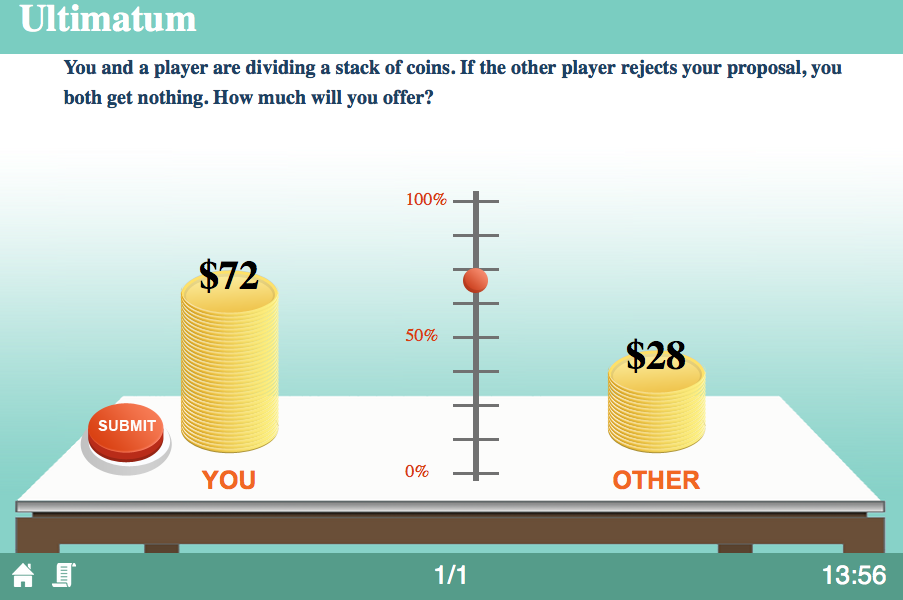They offer game theory courses in High School? (YES!) Here to tell you more about it is Sam Lepler, Economics Instructor at Harker Prep School in San Jose, CA.
Q: First, please tell everyone a little bit about yourself and how you became interested in economics.
A: I am a native Californian, studied college at the University of Pennsylvania undergrad, went to live in Japan and taught English for two years subsequently, and then boomeranged back to California to begin my career as a teacher. I am married with two kids, and I am also a rabid San Jose Sharks fan (I play hockey, too) as well as SF Giants baseball.
I first became interested in Econ in high school through my own AP Economics class. My teacher, Michael Brody, remains a good friend 18 years later to this day, and just made Econ come alive. I ended up majoring in Econ at U of Penn, and went on to get my masters in Econ at San Jose State University. I feel like Econ, albeit pretty much just glorified logic, is an incredibly powerful tool for modeling and understanding human behavior as well as predicting unintended consequences of often well-intentioned, yet counterproductive policies. It’s applicable to so many areas of real life from corporate marketing and pricing strategies to border walls, tariffs, and other current ongoing political debates.
Q: You are teaching game theory at the high school level. Tell us more about that and how MobLab fits in.
A: I am indeed teaching what we call “Honors Advanced Topics in Economics: Game Theory.” The kids like to call it HATE Game Theory :-). We just launched it this past year for seniors who took AP Econ as juniors and were clamoring for more in the economics space. It’s a super applied class that mixes in various aspects of strategic interaction from simple sequential games and simultaneous dominance solvable games, to much more complicated calculus based continuous strategies and oligopoly models, and even strategic moves, voting, auctions, and bargaining. I try to mix theory with mathematics to create a guided applied economics class. I also try to add in behavioral and experimental elements to show the weaknesses of classical game theory as well.
MobLab is the main tool I use for the applied and experimental components. The games that I use range from the standard market model to simple games like the ultimatum game, various matrix games, bidding/auction games, and many more. The games take seconds to set up, a few minutes to play, and then instantaneous feedback about trends and how the theory and practice either converged or diverged and why. This entire section of the class takes minimal prep time and can be effectively executed and impactful in 15 minutes or less. The efficiency and ease of use is remarkable and the reputation of the class as being challenging yet really fun is largely due to MobLab. I actually tabulate game points throughout the semester and assign 10% of the grade based on class ranking on those games to give real incentive for students to try. It works great!
Q: For your strategic moves unit you ran a 10 round-repeated ultimatum game. Tell us a little more about the setup and how you used the game to illustrate threats, promises, commitment strategies, establishing credibility, and countering others’ moves against you. A: Indeed, I did use that game and others to demonstrate the power of strategic moves. By playing many times against the same person, the player who moves second in that ultimatum game can use threats of rejection, which are of course mutually harmful, to get better splits over time. Naturally, their main credibility mechanism is reputation, so many rejected on round one. I was looking to see whether any of them threatened to reject above a 50-50 split, as they could ask for a 70-30 or 90-10 split in their favor. However, none asked for more than 50-50 and pairs where both players were stubborn ended up pretty bad. The chat feature is what allows the threats to be observable so that is essential, but at times students would lie about who they are and pretend to be one of the more irrational students in the class to increase the likely success of a threat. It was awesome to watch the students get creative in figuring out ways to establish credibility, and to see how the first movers tried to counter those threats. One student immediately wrote in chat that he was hiding the chat box and would not read anything anymore, thus cutting off communication and making subsequent threats by player 2 unobservable and therefore ineffective. Very clever!
A: Indeed, I did use that game and others to demonstrate the power of strategic moves. By playing many times against the same person, the player who moves second in that ultimatum game can use threats of rejection, which are of course mutually harmful, to get better splits over time. Naturally, their main credibility mechanism is reputation, so many rejected on round one. I was looking to see whether any of them threatened to reject above a 50-50 split, as they could ask for a 70-30 or 90-10 split in their favor. However, none asked for more than 50-50 and pairs where both players were stubborn ended up pretty bad. The chat feature is what allows the threats to be observable so that is essential, but at times students would lie about who they are and pretend to be one of the more irrational students in the class to increase the likely success of a threat. It was awesome to watch the students get creative in figuring out ways to establish credibility, and to see how the first movers tried to counter those threats. One student immediately wrote in chat that he was hiding the chat box and would not read anything anymore, thus cutting off communication and making subsequent threats by player 2 unobservable and therefore ineffective. Very clever!
Q: How do your students react when you announce that you are playing a MobLab game in class? To encourage thoughtful and strategic game play, do you incentivize winners or mark participation?
A: They ask for MobLab every day–literally! They usually want to finish lectures and going over HW as soon as possible to maximize game time. Of course, those at the top of the leaderboard lead tend to try to stall to minimize the games at times, but even that is a fun game within a game. The reactions when a game goes well or when a partner cheats on a collusive agreement in a prisoner’s dilemma is so fun to watch. They are instantly engaged and incentivized to really think and apply our concepts in a meaningful way since the points rankings directly correspond to grades. Of course, since the points are in rankings, the incentives are a little different compared to if points were dollars, and it might be better to reject in an ultimatum game if the point spread between you and your partner is too large.
Q: What advice would you give a new instructor who wants to use games in their classroom?
 A: My advice is to try the game out with at least one or two practice rounds first. Sometimes it takes some time to understand the settings of a game or to make sure the numbers and payoffs are accurate for the intended game. Also, I would recommend starting with simple games like the ultimatum game or prisoner’s dilemma to make sure the students know how to use the program well. Furthermore, it’s crucial that the points have real meaning be it attached to grades, M&M’s or whatever. Lastly, explore all of the features and games as much as you can. MobLab can be used efficiently and easily to teach nearly every economic topic there is, especially in micro from S+D, price controls, taxes, elasticity, surpluses, externalities, all market structures, and so much more. For larger classes (30+ students), it allows for effective market simulations in a few minutes, so the time savings is crucial compared to other more traditional analog simulations, and the results are instantaneous. I cannot think of another tool out there that allows a teacher to show the effect of so many economic variables (like S+D shifts, etc.) in so little time to make graphs and models meaningful.
A: My advice is to try the game out with at least one or two practice rounds first. Sometimes it takes some time to understand the settings of a game or to make sure the numbers and payoffs are accurate for the intended game. Also, I would recommend starting with simple games like the ultimatum game or prisoner’s dilemma to make sure the students know how to use the program well. Furthermore, it’s crucial that the points have real meaning be it attached to grades, M&M’s or whatever. Lastly, explore all of the features and games as much as you can. MobLab can be used efficiently and easily to teach nearly every economic topic there is, especially in micro from S+D, price controls, taxes, elasticity, surpluses, externalities, all market structures, and so much more. For larger classes (30+ students), it allows for effective market simulations in a few minutes, so the time savings is crucial compared to other more traditional analog simulations, and the results are instantaneous. I cannot think of another tool out there that allows a teacher to show the effect of so many economic variables (like S+D shifts, etc.) in so little time to make graphs and models meaningful.
Would you like to learn more about our online economics games? Get in touch with our team. Click here to schedule a one-on-one demo meeting.

